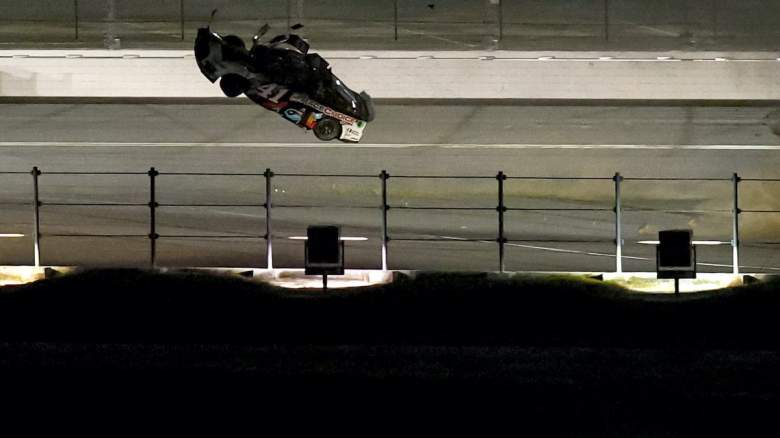
Getty
Several NASCAR Cup Series drivers had safety concerns following the 2023 race at Watkins Glen and not long after the checkered flag fell, sent text messages about those concerns to one person — John Patalak. He’s NASCAR’s vice president of safety engineering, and responsible for overseeing the safety of the sport, including protecting the most important part, the drivers, inside their carefully engineered cars with specially-designed equipment (helmet, fire-resistant suits, restraint system), and various others items (mouthpiece sensors) intended to keep them safe.
The sanctioning body took that feedback from The Glen and addressed those issues, making adjustments to the track before the 2024 event, which was also the 100th points-paying race in the Next Gen/Gen 7 car.
In an interview with the “Beating and Banging” YouTube channel, Patalak gave his top three things in the first 100 races and went big from the start.
“Some of the bigger crashes that we’ve seen — (Ryan) Preece at Daytona (2023) — multiple rollover event and some pretty big loads into the chassis and roll cage where the car was able to do its job. Felt confident in the car with all the testing and design, but it proved out there in that situation.
“Some of the larger crashes we’ve had in the safer barrier. Ryan Blaney at Daytona a few times (2023 and 2024). Or others at some of the other tracks — Ross Chastain out at Fontana early on during practice. We’ve just had some really big crashes — historically large for us — and the drivers and the car have tolerated those well.
“So I think that’s been a really big positive for me. These really severe high-end crashes that drivers are doing well and the cars performing well.”
NASCAR Using Crash Data and Driver Feedback to Improve Safety
Crashing is a part of NASCAR and motorsports. It’s what separates the men from the boys because most humans aren’t okay with getting inside a car and traveling 190 mph knowing it could crash and end tragically. But that’s the reality.
And as much as simulation and modeling might provide a good idea of what might happen during an incident, it’s real-life crashes that produce the most important data and that comes in the form of driver feedback. Patalak said that has been key in making adjustments to the car since its debut in 2022.
“As we’ve gained more and more crash data and had the drivers really help us with things like mouthpiece sensors and their feedback and their input, we’ve been able to make updates to the car — through front- and rear-clip tweaks and design changes,” he said. “A lot of that was a result of getting some real on-track data under our belt from a chassis standpoint
“There’s always a tension in design between crash-worthiness or crushing of the car, to control acceleration versus the operating loads of the car. So being able to jump curbs all day long at a road course, you can’t be bending stuff. But when you crash, you want things to bend in a controlled manner. And as we got more and more data from the cars on track from wheel-force tests and real races and real crashes, we were able to go back and sort of fine-tune some of the front and rear clip areas to improve crash acceleration management.”
Adding Foam and Refocusing on Restraints
Addressing the chassis and, more specifically, modifying the front and rear clips has understandably been a top priority to reduce the painful effects of the front and rear impacts, which were evident in that first year with Kurt Busch getting a concussion and being permanently sidelined after his rear impact at Pocono.
In 2024, NASCAR is getting more nuanced. They’re getting into the details, which is Patalak’s third most notable thing in the first 100 races.
“It’s not particularly car-focused, but it was a renewed emphasis on driver restraint,” he said. “We put a lot of time and effort into developing new rear-impact head foam and that was available to drivers starting in January. Lots of drivers have taken advantage of that and that has showed really good improvements.
“We’ve done a lot more emphasis with preseason at-shop meetings, where we go — NASCAR comes to the shop, talks to the driver, the interior specialist, the crew chief, whoever wants to be there. And in many cases, spend an hour and a half, two, three hours with the driver going through their lap belts, the air and submarine belts, the G belt, shoulder belts, head and neck restraints, helmet, head surround foam. Just sort of getting all of that optimized for the driver when you have the time to do it.
“It’s really hard to do that at the racetrack where everyone’s focused on the weekend’s event. So the last two years, we’ve put a lot of time into doing that with teams, making all the safety officials available to do that.”
NASCAR hasn’t suffered a fatality since the tragic death of Dale Earnhardt in the 2001 Daytona 500. And it’s not by accident.
Comments
NASCAR Safety Boss Talks ‘Historically’ Large Crashes & How Next Gen Has Performed